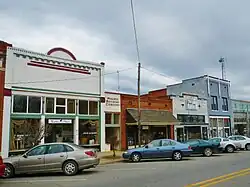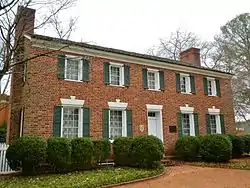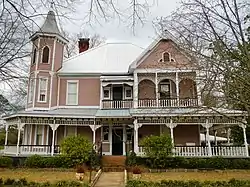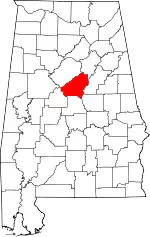Montevallo, Alabama | |
|---|---|
 Montevallo in 2012 | |
 Location of Montevallo in Shelby County, Alabama. | |
| Coordinates: 33°6′18″N 86°51′46″W / 33.10500°N 86.86278°W | |
| Country | United States |
| State | Alabama |
| County | Shelby |
| Settled | 1815 |
| Incorporated | 1848 |
| Government | |
| • Mayor | Rusty Nix |
| Area | |
| • Total | 13.09 sq mi (33.90 km2) |
| • Land | 12.81 sq mi (33.17 km2) |
| • Water | 0.28 sq mi (0.73 km2) |
| Elevation | 433 ft (132 m) |
| Population (2020) | |
| • Total | 7,229 |
| • Density | 564.50/sq mi (217.96/km2) |
| Time zone | UTC−6 (Central (CST)) |
| • Summer (DST) | UTC−5 (CDT) |
| ZIP code | 35115 |
| Area code | 205, 659 |
| FIPS code | 01-50312 |
| GNIS feature ID | 2404287[2] |
| Website | http://www.cityofmontevallo.com/ |
Montevallo is a city in Shelby County, Alabama, United States. A college town, it is the home of the University of Montevallo, a public liberal arts university with approximately 3,000 students. As of the 2020 census, the population of the city of Montevallo is 7,229.
Geography
Montevallo is located at 33°6′18″N 86°51′46″W / 33.10500°N 86.86278°W (33.1049, -86.8628).[3] A plaque on Reynolds Cemetery Road, just off Alabama State Route 25, in the eastern corner of the town, marks the geographic center of the state of Alabama. Middle Street, formerly known as Main Street, had its name changed in 1899 for this reason, upon the completion of a new state survey.[4]
According to the U.S. Census Bureau, the city has a total area of 7.7 square miles (20 km2), of which 7.6 square miles (20 km2) is land and 0.1 square miles (0.26 km2) (0.66%) is water.
History
The area where Montevallo is now was once controlled by the Creek Indians. After being acquired in 1814 Jesse Wilson claimed a small hill on the northern bank of Wilson's Creek by the present Montevallo City Cemetery and created a homestead there, making it the oldest settlement in Shelby County. Wilson's friends and family followed afterwards and also settled in the area, and a settlement known as Wilson's Hill developed on the site. The settlement's location at almost the exact center of Alabama meant it was considered one of the potential sites for the University of Alabama. In an attempt to encourage the university to choose the site the settlement changed its name to Montevallo, which is Italian for the hill in the valley.
Montevallo was used by local farmers as a market town where they could sell and package their produce. It was incorporated as a city in 1848. In 1853 a railway was built between Montevallo and Selma which allowed further economic growth to Montevallo and in 1856 a coal mine was created nearby leading to further growth.
During the American Civil War, Union troops under the command of James H. Wilson camped in Montevallo in the spring of 1865 and skirmished with Confederates near the railroad depot. After the war, commercial life and growth was dominated by the coal mine owned by Truman Aldrich who leased the mine and attempted to increase production in response to the growing iron industry in the region and the growing city of Birmingham. Starting in 1890, company owned worker housing was built in Montevallo to house miners.
.jpg.webp)
In the early 1890s, residents of Montevallo entered the city in a competition to be selected for the site of the Alabama Girl's Industrial School (later the University of Montevallo) a technical college for white women, raising funds to purchase land and antebellum buildings for the college they won and the college was founded in Montevallo in 1896. Commerce and economic growth increased in Montevallo after the establishment of the college, which was renamed Alabama College in 1919, started admitting men in 1956 and started admitting African Americans in 1968 and became the modern liberal arts University of Montevallo. The university became the main source of commerce in Montevallo and money generated by it was used by the municipal government to build schools. The university also allowed the community some stability during the Great Depression. It quickly took over the coal mine as the major employer in Montevallo, the coal mine closing in 1946.[5][6]
Demographics
| Census | Pop. | Note | %± |
|---|---|---|---|
| 1880 | 402 | — | |
| 1890 | 572 | 42.3% | |
| 1910 | 923 | — | |
| 1920 | 850 | −7.9% | |
| 1930 | 1,245 | 46.5% | |
| 1940 | 1,490 | 19.7% | |
| 1950 | 2,150 | 44.3% | |
| 1960 | 2,755 | 28.1% | |
| 1970 | 3,719 | 35.0% | |
| 1980 | 3,965 | 6.6% | |
| 1990 | 4,239 | 6.9% | |
| 2000 | 4,825 | 13.8% | |
| 2010 | 6,323 | 31.0% | |
| 2020 | 7,229 | 14.3% | |
| U.S. Decennial Census[7] 2013 Estimate[8] | |||
2000 census
As of the census[9] of 2000, there were 4,825 people, 1,711 households, and 946 families residing in the city. The population density was 638.5 inhabitants per square mile (246.5/km2). There were 1,897 housing units at an average density of 251.0 per square mile (96.9/km2). The racial makeup of the city was 72.54% White, 25.89% Black or African American, 0.39% Native American, 0.39% Asian, 0.06% Pacific Islander, 0.15% from other races, and 0.58% from two or more races. 1.58% of the population were Hispanic or Latino of any race.
There were 1,711 households, out of which 25.6% had children under the age of 18 living with them, 37.4% were married couples living together, 15.1% had a female householder with no husband present, and 44.7% were non-families. 30.6% of all households were made up of individuals, and 9.9% had someone living alone who was 65 years of age or older. The average household size was 2.30 and the average family size was 2.96.
In the city, the age distribution of the population shows 18.3% under the age of 18, 36.0% from 18 to 24, 21.8% from 25 to 44, 14.1% from 45 to 64, and 9.8% who were 65 years of age or older. The median age was 23 years. For every 100 females, there were 78.1 males. For every 100 females age 18 and over, there were 72.2 males.
The median income for a household in the city was $30,541, and the median income for a family was $40,164. Males had a median income of $36,222 versus $23,705 for females. The per capita income for the city was $16,468. About 14.5% of families and 24.4% of the population were below the poverty line, including 27.6% of those under age 18 and 21.5% of those age 65 or over.
2010 census
As of the census[10] of 2010, there were 6,323 people, 2,346 households, and 1,325 families residing in the city. The population density was 832.0 inhabitants per square mile (321.2/km2). There were 2,654 housing units at an average density of 349.2 per square mile (134.8/km2). The racial makeup of the city was 70.2% White, 24.6% Black or African American, 0.3% Native American, 0.6% Asian, 0.0% Pacific Islander, 2.5% from other races, and 1.8% from two or more races. 5.7% of the population were Hispanic or Latino of any race.
There were 2,346 households, out of which 24.0% had children under the age of 18 living with them, 39.0% were married couples living together, 13.9% had a female householder with no husband present, and 43.5% were non-families. 31.9% of all households were made up of individuals, and 9.9% had someone living alone who was 65 years of age or older. The average household size was 2.29 and the average family size was 2.94.
In the city, the age distribution of the population shows 17.7% under the age of 18, 29.1% from 18 to 24, 22.4% from 25 to 44, 19.8% from 45 to 64, and 11.0% who were 65 years of age or older. The median age was 27 years. For every 100 females, there were 82.2 males. For every 100 females age 18 and over, there were 79.0 males.
The median income for a household in the city was $40,417, and the median income for a family was $75,500. Males had a median income of $53,125 versus $31,361 for females. The per capita income for the city was $19,741. About 11.8% of families and 20.9% of the population were below the poverty line, including 23.6% of those under age 18 and 7.5% of those age 65 or over.
2020 census
| Race | Num. | Perc. |
|---|---|---|
| White (non-Hispanic) | 4,393 | 60.77% |
| Black or African American (non-Hispanic) | 1,638 | 22.66% |
| Native American | 24 | 0.33% |
| Asian | 52 | 0.72% |
| Pacific Islander | 13 | 0.18% |
| Other/Mixed | 339 | 4.69% |
| Hispanic or Latino | 770 | 10.65% |
As of the 2020 United States census, there were 7,229 people, 2,249 households, and 1,234 families residing in the city.
Places of interest
Parnell Memorial Library

The Montevallo Public Library was founded in March 1958 under the leadership of the City of Montevallo and the Montevallo Branch of the American Association of University Women. The library began modestly as a collection of several hundred books in a small room at City Hall. The first librarian was Lillian Ward.
In 1974 the public library was moved to the Depot-in-the-Park, where Mayme Yarbrough was the librarian. It remained there until a 1978 fire destroyed the building and all its contents. The library was relocated to the City Hall Annex until 1984. At that time, the library was moved to the renovated telephone company switching building. The renovation of the building was made possible through the efforts of many people in this community and beyond. From March 1984 until December 2006, that facility served as Montevallo's public library.
In response to the offer from Dr. L. C. Parnell, Jr., to house his Civil War collection in the existing library at 845 Valley Street if an expansion of the library were undertaken, Parnell Memorial Library Foundation was incorporated on March 23, 1998. The mission of the Foundation is to promote funding for expansion of the facilities, services, and programs of Parnell Memorial Library.
As community needs grew, and particularly as community arts programming expanded, it was apparent that Montevallo needed a facility that was more than a traditional library. One of the primary agents of community arts programming is the Montevallo Main Street Players. The community theater group began more than thirty years ago and has performed in various city locations, including the Depot-in-the-Park and the City recreational building. For years, members of the Montevallo Main Street Players have needed a theater, complete with an up-to-date lighting and sound system, that they can use consistently for producing plays and storing props.
In June 2001, representatives from the Foundation, the Montevallo Library Board, the Library Staff, the Montevallo Main Street Players, and the City of Montevallo agreed that the community needed a new library in a new location to meet diverse community needs and to house the Parnell Collection of historical books and documents. The group requested that the City locate property suitable for building a new library that would also serve as a community cultural center. Groundbreaking took place on November 1, 2004, and the Grand Opening was held February 25, 2007.
The new library includes an art gallery and a quality theater used by the Montevallo Main Street Players, the public schools, and other area groups. Along with the large meeting room, the theatre is a much-needed venue for productions by touring theatre companies and musical groups as well as for City of Montevallo meetings and other civic gatherings.
Shoal Creek Park
Shoal Creek Park is a historical 167-acre estate that provides a series of walking and biking trails, in addition to a Pavilion, Antebellum style house, known as Perry Hall, and parking lot, located on Highway 119 in Montevallo surrounding Shoal Creek.
Perry Hall was constructed in 1834 on an 800-acre farm owned by the Perry family. The ownership of the house and land were later transferred to the Mahler family in 1946, and later donated to the city of Montevallo in 2013 by Ms. Elizabeth “Betty” Mahler.[12]
Orr Park
Orr Park, located in Montevallo along Shoal Creek offers residents and visitors a natural recreational environment.[13] Orr Park offers two playgrounds, six baseball/softball fields, a walking trail, a football field and a practice field.

Orr Park contains a local attraction dubbed "Tinglewood". In the early 1990s, local artist Tim Tingle, a coal miner by trade, took it upon himself to transform storm-damaged cedar trees into works of art. The carvings feature gnomes, a dragon, and a fish eating a snake, among others.[14]
American Village
The American Village is a classroom and American history and civics education center. The American Village serves the Nation as an educational institution whose mission is to strengthen and renew the foundations of American liberty and self-government by engaging and inspiring citizens and leaders, with a special emphasis on programs for young people.[15]
Notable people
- Slade Blackwell, member of the Alabama Senate
- Andrew Jackson Caldwell, U.S. Representative from Tennessee from 1883 to 1887
- James Hardy, surgeon who performed the first successful human lung transplant. Was born in Newala, a small community outside of Montevallo.
- Jim Hayes, former Major League Baseball player for the Washington Senators
- Polly Holliday, actress in TV series such as Alice and movies such as All the President's Men and Mrs. Doubtfire.
- Frank Ragan King, Commander in the United States Navy who was awarded the Distinguished Service Medal
- Burwell Boykin Lewis, former member of the Alabama House of Representatives and president of the University of Alabama from 1880 to 1885
- Robert M. Lightfoot, Jr., 11th director of NASA Marshall Space Flight Center
- Piano "C" Red, (1933–2013), Chicago blues and boogie-woogie pianist, singer and composer[16]
- Eugene Bondurant Sledge, United States Marine, university professor, and author
Sister city
|
The friendly relationship between Echizen Town and Montevallo began in 1995 with a common interest in pottery. Echizen Town is well known for its unusual pottery and the University of Montevallo excels in teaching and creating the art.[17] Echizen Town is also well known in Japan for its high quality crab, rice, and daffodils. Many people often confuse Echizen Town with Echizen City, a larger city to the south of Echizen Town, known for its production of knives and paper.
Gallery
 Montevallo City Hall
Montevallo City Hall.JPG.webp) Montevallo Post Office (ZIP code: 35115)
Montevallo Post Office (ZIP code: 35115) Parnell Memorial Library
Parnell Memorial Library Built in the Federal style in 1823, the King House is the oldest building on the campus of the University of Montevallo. It was added to the National Register of Historic Places on January 14, 1972.
Built in the Federal style in 1823, the King House is the oldest building on the campus of the University of Montevallo. It was added to the National Register of Historic Places on January 14, 1972. Built in 1900, the McKibbon House is a historic Victorian home located in Montevallo. The home is now used as a bed and breakfast. It was added to the National Register of Historic Places on December 31, 2001.
Built in 1900, the McKibbon House is a historic Victorian home located in Montevallo. The home is now used as a bed and breakfast. It was added to the National Register of Historic Places on December 31, 2001. Shoal Creek at Orr Park in Montevallo.
Shoal Creek at Orr Park in Montevallo. Tim Tingle's carving of a man's face in the trees at Orr Park.
Tim Tingle's carving of a man's face in the trees at Orr Park.
References
- ↑ "2020 U.S. Gazetteer Files". United States Census Bureau. Retrieved October 29, 2021.
- 1 2 U.S. Geological Survey Geographic Names Information System: Montevallo, Alabama
- ↑ "US Gazetteer files: 2010, 2000, and 1990". United States Census Bureau. February 12, 2011. Retrieved April 23, 2011.
- ↑ "Alabama Department of Archives and History". state.al.us.
- ↑ "Montevallo". Encyclopedia of Alabama.
- ↑ "The Official Website of Montevallo, Alabama – Historical Commission". homestead.com.
- ↑ "U.S. Decennial Census". Census.gov. Retrieved June 6, 2013.
- ↑ "Annual Estimates of the Resident Population: April 1, 2010 to July 1, 2013". Retrieved June 3, 2014.
- ↑ "U.S. Census website". United States Census Bureau. Retrieved January 31, 2008.
- ↑ "U.S. Census website". United States Census Bureau. Retrieved August 8, 2015.
- ↑ "Explore Census Data". data.census.gov. Retrieved December 11, 2021.
- ↑ "Shoal Creek Park". Shoal Creek Park Foundation. Retrieved September 26, 2023.
- ↑ "Orr Park". Shelby County Tourism. Retrieved January 20, 2014.
- ↑ "Orr Park". Parks and Recreation. cityofmontevallo.com. Retrieved January 25, 2019.
- ↑ "American Village Citizenship Trust". americanvillage.org. Retrieved April 16, 2021.
- ↑ "Piano C Red drove a taxi by day and played blues piano at night". Rockandrollparadise.com. October 10, 2016. Retrieved November 27, 2022.
- ↑ Montevallo Sister City Commission, Montevallo Sister City Commission, retrieved February 25, 2012
External links
- City of Montevallo: Official City Website
- Parnell Memorial Library Foundation:Parnell Memorial Library Foundation
